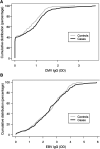Cytomegalovirus, Epstein-Barr virus and risk of breast cancer before age 40 years: a case-control study
- PMID: 15150559
- PMCID: PMC2409506
- DOI: 10.1038/sj.bjc.6601822
Cytomegalovirus, Epstein-Barr virus and risk of breast cancer before age 40 years: a case-control study
Abstract
We investigated whether there is an association between cytomegalovirus (CMV) and Epstein-Barr virus (EBV) IgG levels and risk of breast cancer before age 40 years. CMV and EBV IgG levels were measured in stored plasma from 208 women with breast cancer and 169 controls who participated in the Australian Breast Cancer Family Study (ABCFS), a population-based case-control study. CMV and EBV IgG values were measured in units of optical density (OD). Cases and controls did not differ in seropositivity for CMV (59 and 57% respectively; P=0.8) or EBV (97 and 96% respectively; P=0.7). In seropositive women, mean IgG values were higher in cases than controls for CMV (1.20 vs 0.98 OD, P=0.005) but not for EBV (2.65 vs 2.57 OD, P=0.5). The adjusted odds ratios per OD unit were 1.46 (95% CI 1.06-2.03) for CMV IgG and 1.11 (0.93-1.33) for EBV IgG. The higher mean CMV IgG levels found in women with breast cancer could be the result of a more recent infection with CMV, and may mean that late exposure to CMV is a risk factor for breast cancer.
Figures
References
-
- Bonnet M, Guinebretiere JM, Kremmer E, Grunewald V, Benhamou E, Contesso G, Joab I (1999) Detection of Epstein–Barr virus in invasive breast cancers. J Natl Cancer Inst 91: 1376–1381 - PubMed
-
- Fina F, Romain S, Quafik LH, Palmari J, Ben Ayed F, Benharkat S, Bonnier P, Spyratos F, Foekens JA, Rose C, Buisson M, Gerard H, Reymond MO, Seigneurin JM, Martin PM (2001) Frequency and genome load of Epstein–Barr virus in 509 breast cancers from different geographical areas. Br J Cancer 84: 783–790 - PMC - PubMed
-
- Hopper JL, Chevenix-Trench G, Jolley DJ, Dite GS, Jenkins MA, Venter DJ, McCredie MR, Giles GG (1999) Design and analysis issues in a population-based case–control-family study of the genetic epidemiology of breast cancer and the co-operative family registry for breast cancer studies (CFRBCS). Monogr Natl Cancer Inst 26: 95–100 - PubMed


